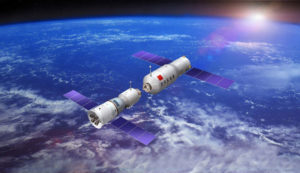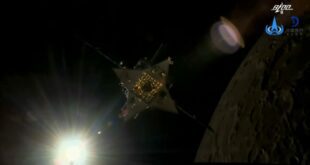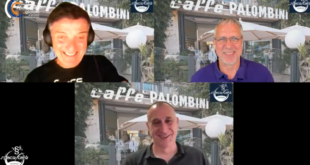 As part of the partnership between SpaceWatch.Global and the European Space Policy Institute, we have been granted permission to publish selected articles and briefs. This is ESPI Briefs No. 20: ‘Uncontrolled Re-Entries: Outstanding Issues and Considerations for the Future ’, originally published in February 2018.
As part of the partnership between SpaceWatch.Global and the European Space Policy Institute, we have been granted permission to publish selected articles and briefs. This is ESPI Briefs No. 20: ‘Uncontrolled Re-Entries: Outstanding Issues and Considerations for the Future ’, originally published in February 2018.
As communicated to the UN Secretary-General in a note verbale released on 8 December 2017, China’s Tiangong-1 space laboratory will re-enter the atmosphere between late February and late March 2018. The possibility that some parts of the spacecraft survive re-entry and impact on populated areas has inevitably generated media attention, raising a number of pressing questions on the issue of atmospheric re-entries.
1. Why Re-Entry is a Critical Safety Issue

In an increasingly congested space environment, atmospheric re-entries can be seen favourably as they contribute to reducing the debris population. Re-entries, however, can also pose a hazard to people, property or the environment, especially when the decayed space objects do not completely vaporise in the atmosphere and do not follow a controlled trajectory ending at a known and safe location – typically over an ocean. In the past, some atmospheric re-entries have had dramatic consequences. For instance, in 1978 the Soviet reconnaissance satellite Cosmos 954 crashed in the north-west part of Canada, causing the dispersion of numerous components contaminated with radiation from the nuclear reactor powering the satellite.
Since 1957, more than 24,000 orbiting objects have re-entered into the Earth’s atmosphere, accounting for a total mass of ∼32,000 metric tons. Every year, 200 to 400 trackable objects re-enter in the atmosphere. While the majority of these objects are small orbital debris that do not survive the extreme heat of re-entry, almost the entirety of the re-entered mass (∼99%) corresponds to large objects (i.e. spacecraft, spent upper stages and platforms). Roughly 70% of these re-entries are uncontrolled, corresponding to about 100 metric tons per year. On average, there is one uncontrolled re-entry of a spacecraft or rocket body every week.
While the odds of being hit by incoming debris are very low – since 1957 only one person has ever claimed to be hit by a debris – hazards posed by uncontrolled re-entry cannot be overlooked. This primarily stems from the fact that it is extremely difficult to predict the exact time, location and impact of an uncontrolled re-entry. Due to the great speed of re-entering objects, even predictions made few hours before the impact can be incorrect by hundreds to thousands of kilometres, making it impossible for civil protection authorities to take appropriate measures. In addition, recent studies presented at the 2017 European Space Debris Conference have highlighted the possibility that “uncontrolled re-entries of sizable space objects will become of growing concern in the coming years, due to a combined effect of the increasing use of space and population growth” as well as an increased utilisation of materials for spacecraft manufacturing (e.g. titanium) which survive re-entry.
2. International Measures for Re-Entry: What are the Gaps?
At national level, several organizations around the world have already adopted specific measures to minimize the risk to human life and property on the ground. These measures include the establishment of crisis units by national civil protection departments as well as contingency plans and programmes to dispatch information on the re-entry by means of issuing periodical reports to the potentially affected states and the general public.
At international level, the members of the Inter-Agency Space Debris Coordination Committee (IADC) have been conducting annual object re-entry prediction campaigns for performing risk and prediction analyses. In addition, the IADC has advised in its Mitigation guidelines that “if a spacecraft or orbital stage is to be disposed of by re-entry into the atmosphere, debris that survive to reach the surface of the Earth should not pose an undue risk to people or property”. To limit the risk of objects surviving atmospheric re-entry, the IADC recommends designing spacecraft in such a way that they will completely vaporise during re-entry. The International Organisation for Standardisation (ISO) has also been developing space systems disposal standards to support compliance with these guidelines. If such an option is not viable, the IADC underlines the necessity of performing a controlled re-entry that will confine the debris to uninhabited regions, such as broad ocean areas. Also, the guidelines affirm that “ground environmental pollution, caused by radioactive or toxic substances should be prevented or minimised in order to be accepted as permissible. In the case of a controlled re-entry of a spacecraft or orbital stage, the operator of the system should inform the relevant air traffic and maritime traffic authorities of the re-entry time and trajectory and the associated ground area”.
Although international guidelines define rather clearly what should be avoided during re-entries, it does not go unnoticed that there are still many gaps as well as lack of transparency when it comes to the implementation of these re-entry standards and procedures. Different sets of problem arise. For one thing, it must be acknowledged that there is no international and legally-binding definition of acceptable safety risk, which is left to national authorities. More broadly, the IADC guidelines – which are based on voluntary compliance – simply indicate what should be achieved, but not how to do it.
By the same token, it must be noted that implementing the recommended procedures might not always be possible. On one hand, it was found that even in the case of objects designed to vaporise during re-entry, a fraction between 5% and 40% of the satellite´s mass might reach the surface of the Earth, depending on its weight, size, shape and composition. On the other hand, it can be observed that even spacecraft designed for a controlled re-entry (e.g. ENVISAT), can suffer damages affecting this capability and forcing them to re-enter the atmosphere in an uncontrolled way.
Another set of problems stems from the current level of information sharing. Both the IADC Guidelines and the Transparency and Confidence Building Measures (TCBMs) endorsed by the UN in 2013 invite States to notify all other potentially affected States, the Secretary-General of the UN and relevant international organisations of predicted high-risk re-entry events, i.e. by providing technical information on the estimated casualty area as well as indications on the material compositions of the spacecraft and the presence of dangerous material aboard. However, such information is not always shared for fear of revealing sensitive data. This inevitably impacts the accuracy of re-entry predictions. There are also several instances of classified military satellites’ re-entries where notifications have not been even issued.
3. Considerations for the Future
Effectively mitigating the risks associated with atmospheric re-entries will require a comprehensive approach which addresses all of the above-identified shortfalls. Towards this, more complete regulatory procedures governing re-entries will have to be put in place along with appropriate technical solutions to implement these procedures and an effective international cooperation scheme to share information. This issue has been already identified within the Long-Term Sustainability (LTS) guidelines, currently under finalisation at the UNCOPUOS. However, the content of the guidelines has been somehow weakened during recent negotiations and questions remains on whether voluntary, non-binding rules will suffice to mitigate effectively safety issues raised by atmospheric re-entries.
Among the procedures to be further elaborated in order to address the problem at its roots is the retrieval of large space objects, which is already acknowledged as a post-disposal option. In light of the upcoming Tiangong-1 re-entry or of the still-unsettled decommissioning of the ISS – due considerations should be paid to the definition of internationally agreed procedures for active removal of large space objects which may not be controlled during their atmospheric re-entry. Such procedures would inevitably raise a plethora of technical, legal, financial and operational issues that affects the practicality of the active removal option.
All in all, while no concrete breakthrough is on the horizon, should the re-entry of Tiangong-1 or of other space objects cause major accidents affecting human lives or critical infrastructures, the quest for effective solutions would certainly be brought higher in the international space agenda.
Rights reserved – this publication is reproduced with permission from ESPI. “Source: ESPI “ESPI Briefs” No. 20, February 2018. All rights reserved”
For more articles please visit ESPI website (www.espi.or.at).





